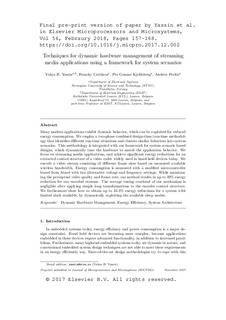| dc.contributor.author | Yassin, Yahya Hussain | |
| dc.contributor.author | Catthoor, Francky | |
| dc.contributor.author | Kjeldsberg, Per Gunnar | |
| dc.contributor.author | Perkis, Andrew | |
| dc.date.accessioned | 2019-01-09T13:19:41Z | |
| dc.date.available | 2019-01-09T13:19:41Z | |
| dc.date.created | 2018-11-15T14:53:25Z | |
| dc.date.issued | 2018 | |
| dc.identifier.citation | Microprocessors and microsystems. 2018, 56 157-168. | nb_NO |
| dc.identifier.issn | 0141-9331 | |
| dc.identifier.uri | http://hdl.handle.net/11250/2579996 | |
| dc.description.abstract | Many modern applications exhibit dynamic behavior, which can be exploited for reduced energy consumption. We employ a two-phase combined design-time/run-time methodology that identifies different run-time situations and clusters similar behaviors into system scenarios. This methodology is integrated with our framework for system scenario based designs, which dynamically tune the hardware to match the application behavior. We focus on streaming media applications, and achieve significant energy reductions for an extracted control structure of a video codec widely used in hand-held devices today. We encode a video stream consisting of different frame sizes based on measured available wireless bandwidth. Energy consumption is measured with a modified microcontroller board from Atmel with two alternative voltage and frequency settings. While maintaining the perceptual video quality and frame rate, our method results in up to 49% energy reduction for our encoded streams. The average tuning overhead of our mechanism is negligible after applying simple loop transformations to the encoder control structure. We furthermore show how to obtain up to 34.3% energy reductions for a system with limited slack available, by dynamically exploiting the available sleep modes. | nb_NO |
| dc.language.iso | eng | nb_NO |
| dc.publisher | Elsevier | nb_NO |
| dc.rights | Attribution-NonCommercial-NoDerivatives 4.0 Internasjonal | * |
| dc.rights.uri | http://creativecommons.org/licenses/by-nc-nd/4.0/deed.no | * |
| dc.title | Techniques for dynamic hardware management of streaming media applications using a framework for system scenarios | nb_NO |
| dc.type | Journal article | nb_NO |
| dc.type | Peer reviewed | nb_NO |
| dc.description.version | acceptedVersion | nb_NO |
| dc.source.pagenumber | 157-168 | nb_NO |
| dc.source.volume | 56 | nb_NO |
| dc.source.journal | Microprocessors and microsystems | nb_NO |
| dc.identifier.doi | 10.1016/j.micpro.2017.12.002 | |
| dc.identifier.cristin | 1631071 | |
| dc.description.localcode | © 2017. This is the authors’ accepted and refereed manuscript to the article. Locked until 9.12.2019 due to copyright restrictions. This manuscript version is made available under the CC-BY-NC-ND 4.0 license http://creativecommons.org/licenses/by-nc-nd/4.0/ | nb_NO |
| cristin.unitcode | 194,63,35,0 | |
| cristin.unitname | Institutt for elektroniske systemer | |
| cristin.ispublished | true | |
| cristin.fulltext | postprint | |
| cristin.qualitycode | 1 | |

